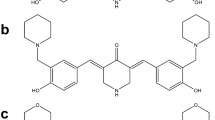Abstract
We have previously reported that when mixed with copper, 8-hydroxyquinoline (8-OHQ) and its analog clioquinol (CQ) inhibited the proteasomal activity and proliferation in cultured human cancer cells. CQ treatment of high-copper-containing human tumor xenografts also caused cancer suppression, associated with proteasome inhibition in vivo. However, the nature of the copper dependence of these events has not been elucidated experimentally. In the current study, using chemical probe molecules that mimic the structures of 8-OHQ and CQ, but have no copper-binding capability, we dissected the complex cellular processes elicited by 8-OHQ–Cu and CQ–Cu mixtures and revealed that copper binding to 8-OHQ or CQ is required for transportation of the copper complex into human breast cancer cells and the consequent proteasome-inhibitory, growth-suppressive, and apoptosis-inducing activities. In contrast, the non-copper-binding analogs of 8-OHQ or CQ blocked the very first step—copper binding—in this chain of events mediated by 8-OHQ–Cu or CQ–Cu.







Similar content being viewed by others
References
Labbe S, Thiele DJ (1999) Trends Microbiol 7:500–505
Maverakis E, Fung MA, Lynch PJ, Draznin M, Michael DJ, Ruben B, Fazel N (2007) J Am Acad Dermatol 56:116–124
Geraki K, Farquharson MJ, Bradley DA (2002) Phys Med Biol 47:2327–2339
Nayak SB, Bhat VR, Upadhyay D, Udupa SL (2003) Indian J Physiol Pharmacol 47:108–110
Diez M, Arroyo M, Cerdan FJ, Munoz M, Martin MA, Balibrea JL (1989) Oncology 46:230–234
Yoshida D, Ikeda Y, Nakazawa S (1993) J Neurooncol 16:109–115
Eatock MM, Schatzlein A, Kaye SB (2000) Cancer Treat Rev 26:191–204
Fox SB, Gasparini G, Harris AL (2001) Lancet Oncol 2:278–289
Brewer GJ (2001) Exp Biol Med (Maywood) 226:665–673
Adsule S, Barve V, Chen D, Ahmed F, Dou QP, Padhye S, Sarkar FH (2006) J Med Chem 49:7242–7246
Brewer GJ, Dick RD, Grover DK, LeClaire V, Tseng M, Wicha M, Pienta K, Redman BG, Jahan T, Sondak VK, Strawderman M, LeCarpentier G, Merajver SD (2000) Clin Cancer Res 6:1–10
Redman BG, Esper P, Pan Q, Dunn RL, Hussain HK, Chenevert T, Brewer GJ, Merajver SD (2003) Clin Cancer Res 9:1666–1672
Landis-Piwowar KR, Milacic V, Chen D, Yang H, Zhao Y, Chan TH, Yan B, Dou QP (2006) Drug Resist Updates 9:263–273
Orlowski RZ, Dees EC (2003) Breast Cancer Res 5:1–7
Ciechanover A (1998) EMBO J 17:7151–7160
Seemuller E, Lupas A, Stock D, Lowe J, Huber R, Baumeister W (1995) Science 268:579–582
Kisselev AF, Callard A, Goldberg AL (2006) J Biol Chem 281:8582–8590
An B, Goldfarb RH, Siman R, Dou QP (1998) Cell Death Differ 5:1062–1075
Lopes UG, Erhardt P, Yao R, Cooper GM (1997) J Biol Chem 272:12893–12896
Nordenberg J, Novogrodsky A, Beery E, Patia M, Wasserman L, Warshawsky A (1990) Eur J Cancer 26:905–907
Shen AY, Wu SN, Chiu CT (1999) J Pharm Pharmacol 51:543–548
Moret V, Laras Y, Cresteil T, Aubert G, Ping DQ, Di C, Barthelemy-Requin M, Beclin C, Peyrot V, Allegro D, Rolland A, De Angelis F, Gatti E, Pierre P, Pasquini L, Petrucci E, Testa U, Kraus JL (2009) Eur J Med Chem 44:558–567
Deraeve C, Boldron C, Maraval A, Mazarguil H, Gornitzka H, Vendier L, Pitie M, Meunier B (2008) Chemistry 14:682–696
Martirosyan AR, Rahim-Bata R, Freeman AB, Clarke CD, Howard RL, Strobl JS (2004) Biochem Pharmacol 68:1729–1738
Dou QP, Li B (1999) Drug Resist Updates 2:215–223
Adams J (2003) Drug Discov Today 8:307–315
Ding WQ, Liu B, Vaught JL, Yamauchi H, Lind SE (2005) Cancer Res 65:3389–3395
Daniel KG, Chen D, Orlu S, Cui QC, Miller FR, Dou QP (2005) Breast Cancer Res 7:R897–R908
Chen D, Peng F, Cui QC, Daniel KG, Orlu S, Liu J, Dou QP (2005) Front Biosci 10:2932–2939
Li L, Xu B (2008) Tetrahedron 64:10986–10995
Bevan JA, Graddon DP, McConnell JF (1963) Nature 199:363
Daniel KG, Gupta P, Harbach RH, Guida WC, Dou QP (2004) Biochem Pharmacol 67:1139–1151
Chen D, Cui QC, Yang H, Barrea RA, Sarkar FH, Sheng S, Yan B, Reddy GP, Dou QP (2007) Cancer Res 67:1636–1644
Treiber C, Simons A, Strauss M, Hafner M, Cappai R, Bayer TA, Multhaup G (2004) J Biol Chem 279:51958–51964
Mao X, Li X, Sprangers R, Wang X, Venugopal A, Wood T, Zhang Y, Kuntz DA, Coe E, Trudel S, Rose D, Batey RA, Kay LE, Schimmer AD (2009) Leukemia 23:585–590
Filiz G, Caragounis A, Bica L, Du T, Masters CL, Crouch PJ, White AR (2008) Int J Biochem Cell Biol 40:1030–1042
Vaira MD, Bazzicalupi C, Orioli P, Messori L, Bruni B, Zatta P (2004) Inorg Chem 43:3795–3797
Ferrada E, Arancibia V, Loeb B, Norambuena E, Olea-Azar C, Huidobro-Toro JP (2007) Neurotoxicology 28:445–449
Pink JJ, Wuerzberger-Davis S, Tagliarino C, Planchon SM, Yang X, Froelich CJ, Boothman DA (2000) Exp Cell Res 255:144–155
Cvek B, Milacic V, Taraba J, Dou QP (2008) J Med Chem 51:6256–6258
Harris ED (2000) Annu Rev Nutr 20:291–310
Acknowledgments
This work was supported by Shandong University, the American Lebanese Syrian Associated Charities (ALSAC), and St. Jude Children’s Research Hospital (B.Y.)., and research funds from the Karmanos Cancer Institute of Wayne State University (Q.P.D.), the Department of Defense Breast Cancer Research Program (W81XWH-04-1-0688, DAMD17-03-1-0175; Q.P.D.) and the National Cancer Institute (1R01CA120009, 1R21CA139386-01; Q.P.D.).
Author information
Authors and Affiliations
Corresponding authors
Electronic supplementary material
Below is the link to the electronic supplementary material.
Rights and permissions
About this article
Cite this article
Zhai, S., Yang, L., Cui, Q.C. et al. Tumor cellular proteasome inhibition and growth suppression by 8-hydroxyquinoline and clioquinol requires their capabilities to bind copper and transport copper into cells. J Biol Inorg Chem 15, 259–269 (2010). https://doi.org/10.1007/s00775-009-0594-5
Received:
Accepted:
Published:
Issue Date:
DOI: https://doi.org/10.1007/s00775-009-0594-5




